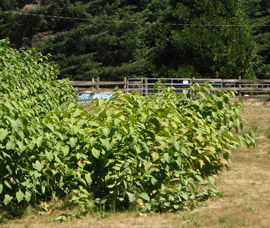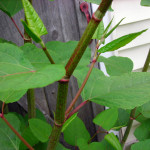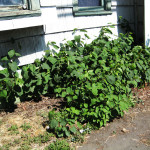
Knotweed (Polygonum spp.) is a highly invasive, perennial plant native to Japan, China, and Korea. The World Conservation Union lists it as one of the world’s 100 worst invasive species for good reason. It colonizes streamsides, roadsides, and areas of human disturbance. With its fast growth and expansive root mass, it outcompetes and replaces native vegetation.
Knotweed causes big problems along streams, which is why it’s one of EMSWCD’s highest priorities for removal. Its root system is primarily made up of thick underground stems called rhizomes with very little fine root material. This root structure does not do a good job of holding soil together compared to the native trees it replaces. As a result, streambanks can erode during big rain storms. Additionally, many of the native plants that knotweed replaces would have eventually grown up to be tall shade trees. With less shade trees over the stream, more sunlight reaches the water, raising stream temperatures. Warm streams are harmful to salmon.
Knotweed spreads rapidly along streams and rivers because it can create a new plant from a small fragment of its root or stem. This is why cutting is not a recommended method for removal. New plants can grow from any root or stem pieces left behind. After a flood, an established knotweed plant can break up and transplant downstream. In this manner, a watershed-wide outbreak can result from a small infestation. This in turn can cause degraded water quality and ultimately an ecosystem with less biodiversity. Of particular importance here in Multnomah County is the Sandy River. It’s one of the few remaining salmon-bearing river systems that flows freely from source to sea, with no dams to block salmon migration. The management of knotweed is critical to maintaining the health of this watershed.
Identification
- Knotweed has hollow stems with raised nodes, giving it a similar appearance to bamboo.
The main varieties of Knotweed are Japanese, Himalayan, giant and a hybrid of Japanese and giant called bohemian Knotweed. Himalayan knotweed grows up to 6 feet tall. Japanese knotweed can reach 12 feet tall and giant knotweed can grow up to 15 feet tall. Japanese knotweed is by far the most common type of knotweed in the Pacific Northwest. Knotweed has hollow stems with distinct raised nodes that give it a very similar appearance to bamboo, though they are not closely related. While large mature plants can grow tall each growing season, it is typical to see much smaller plants in the shade or when they’re young. The flowers are small, creamy white, blooming in late summer and early autumn. It is an herbaceous plant that dies back to the ground every winter, but comes back bigger and stronger the following summer.
Control
- Manual control is not recommended – digging and disturbance is known to increase root density and can even cause the formation of new patches.
- In urban areas and homes, knotweed grows aggressively and can quickly take over yards and landscaping. It can also impact a house’s foundation.
Knotweed evolved to withstand volcanic eruptions and is notoriously hard to kill. Free treatment is available for knotweed found in along streams. If you have found a knotweed patch in an upland area and wish to control it, know that knotweed is not easy to control. The extensive underground root system can sustain the plant even when the above ground growth is removed. Therefore, targeting the root system is critical to the management of knotweed. This is best achieved using a chemical treatment. EMSWCD offers free consultation in these situations.
Manual control (digging or cutting) of knotweed is only recommended for the most tenacious and dedicated gardeners and when the infestation is less than a few feet across. Digging and cutting is known to increase the density of the infestation and can even spread it if the root material is not disposed of carefully. Even when removal is done carefully and thoroughly, it will require years of repeated control. Please contact district staff to develop a strategy if you are interested in pursuing manual control of this species.
If you choose to use herbicides, always read the entire label and carefully follow the instructions. Adhere to the label requirements for application, mixing, and loading setbacks from wells, streams and rivers, and other water bodies. Always wear appropriate protective clothing and gear.
Report Sightings!
If you think you have found this plant please report it. This plant is on our high priority list, and we provide free control in streamside areas. Report a sighting!
More Photos
To see more photos of knotweed click here



